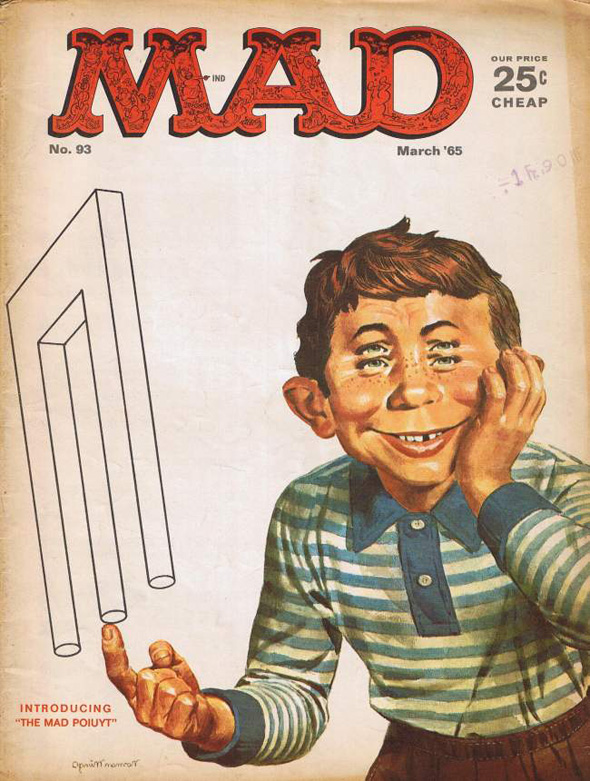 A blivet, also known as a poiuyt or even more often refereed to as “The Devil’s Fork” is an undecipherable figure, an optical illusion and an impossible object we’ve encountered many times here on Mighty Optical Illusions blog – yet I feel we’ve never given it proper attention, explained how it works nor talked how it came to be…
A blivet, also known as a poiuyt or even more often refereed to as “The Devil’s Fork” is an undecipherable figure, an optical illusion and an impossible object we’ve encountered many times here on Mighty Optical Illusions blog – yet I feel we’ve never given it proper attention, explained how it works nor talked how it came to be…
In most cases, (yet not always necessarily) it appears to have three cylindrical prongs at one end which mysteriously transform into two rectangular prongs at the other end. In our illusion world, it’s most often showcased in a form of a Roman Columns.
Blivet refers to an indecipherable figure, such as one that can be seen illustrated above (taken from Working Daze comic by John Zakour). One of the earliest appearances can be linked to the March 1965 cover of Mad magazine (below), where it was dubbed the “Three-Pronged Poiuyt“, and has appeared numerous times since then. An anonymously-contributed version described as a “hole location gauge” was printed in the June 1964 issue of Analog Science Fiction and Fact, with the comment that “this outrageous piece of draftsmanship evidently escaped from the Finagle & Diddle Engineering Works”.
 The graphic artist M.C. Escher also used these types of figures as the basis for his impossible 3D compositions in many of his woodcut prints, most of which can be easily found if you browse this site’s archives.
The graphic artist M.C. Escher also used these types of figures as the basis for his impossible 3D compositions in many of his woodcut prints, most of which can be easily found if you browse this site’s archives.
In December 1968 American optical designer and artist Roger Hayward wrote “Blivets: Research and Development” for The Worm Runner’s Digest in which he presented interpretations of the blivet…
Let’s take a look at some of the illusions blivet has appeared in, and if this still isn’t enough, feel free to browse some of the links inside this article, or take a glimpse inside our #impossible objects category.
Blivet appeared on the March 1965 cover of Mad magazine, where it was dubbed the “Three-Pronged Poiuyt” (the last six letters on the top row of many Latin-script typewriter keyboards, right to left), and has appeared numerous times since then.






Truly, one of the most remarkable illusions with one of the most robust effects. There is a three dimentional solution to this illusion when it is in its prone or lateral positions ( I published it in the British Journal of perception,1975). The mind tries so hard to make choas predictable.
Does anybody realise that the guy on the MAD cover does the drunk test, and we’re all drunk because nobody noticed it the first time scrolling down? XD Keep these coming Vurdlak!
lol devils forklift
The tree picture doesn’t seem to fit with the others.
Lots of lovely images to amaze today. Wonderful, thank you.
First! Very cool!
Here is an interesting picture I found on facebook. It looks like Micheal Obama is an extra arm, like an Indian goddess of nature or arthropod or something. Fitting for earth day no? [img]https://sphotos-a.xx.fbcdn.net/hphotos-ash3/63093_10151388893131545_50153984_n.png[/img]
first comment!! this one might be my favorite! :-)
Note that the name “poiuyt” is simply the end of “QWERTYUIOP” written backwards.
I’m honored that you chose to include our WORKING DAZE appearance of the Blivet to head your article. No quite as honored that you didn’t mention my name as co-creator. I actually wrote that one because we had to replace a gag that week and I couldn’t get one from John in time. I’d been drawing that illusion all my life, since I first saw it in school. This panel presented a challenge peculiar to the blivet: it’s hard to render it in a color illustration without destroying the illusion- so I had to leave a lot of white space around it. Clearly Norman Mingo- or ogniM namroN- ran into the same problem with the MAD cover.
for the 4 3 pic just look at the four side than follow the line they don’t connets them
But who did created the blivet?? on wikipedia and here it’s says “first introduced by MAD magazine on march of ’65” but never says who was the genius behind it…
Here’s a real Devil’s Fork